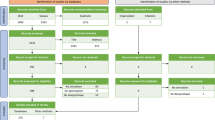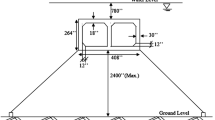Abstract
This paper presents the survey and assessment of the estimation techniques on hydrodynamic impact. The description and definition of hydrodynamic impact are presented, and the categorization of prediction techniques and the difficulties are discussed. Analysis theories and numerical simulation techniques are reviewed and the characteristics of those theories and approaches are analyzed. The efforts are made to pinpoint the advantages and disadvantages. Recommendations for further research and development are made.
摘 要
文章对水动力砰击预报技术进行了研究与评估. 介绍了水动力砰击现象的描述、 定义, 对预报方法和理论进行了分类, 并讨论了预报技术中的困难与难点. 综合叙述了预报方法的理论分析与数值模拟, 指出这些预报方法的优点与缺点, 并对今后的研究与开发工作给出几点建议.
Similar content being viewed by others
References
ROSENBLATT M. Hydrodynamic impact on displacement ship hulls[R]. Washington, D C: Ship Structure Committee: PB96–12901, 1995.
OCHI M K, MOTTER L E. Prediction of slamming characteristics and hull responses for ship design[J]. SNAME Transactions, 1973, 81: 144–176.
OCHI M K. Experiments on the effective of bow form on ship slamming[R]. DTMB: report1400, 1962.
STAVOVY A B, CHANG S L. Analytical determination of slamming pressure for high speed vehicles in waves[J]. Journal of Ship Research, 1976, 20(4): 190–198.
VON K. The impact of seaplane floats during landing[R]. NACA TN 321, Washington D C: National Advisory Committee for Aeronautics, 1929.
CHU W, ABRAMSON H N. Hydrodynamic theories of ship slamming-review and extension[J]. Journal of Ship Research, 1961, 4(4): 9–21.
WAGNER H. Uber stoss-und gleitvorgange an der oberflache von flussigkeiten[J]. Zeitschrift für Angewandte Mathematik und Mechanik, 1932, 12(4): 193–215.
ARMAND J L, COINTE R. Hydrodynamic impact analysis of a circular cylinder[C]// Proc 5th International Offshore Mechanics and Arctic Engineering. Tokyo, 1987: 609–634.
SZEBEHELY V G. Hydrodynamic approach to the slamming of ships[C]// 2nd Mid-western Conference on Fluid Mechanics. 1952.
HOWIS S D, OCHENSON J R, WILSON S K. Incompressible water entry problems at small deadrise angles[J]. Journal of Fluid Mechanics, 1991, 222: 215–230.
ZHAO R, FALTINSEN O M. Water entry of two-dimensional bodies[J]. Journal of Fluid Mechanics, 1993, 246: 593–612.
WANATABLE T. Analytical expression of hydrodynamic impact pressure by matched asymptotic expansion technique[J]. Trans West-Japan Society of Naval Architect, 1986, 71(1): 77–85.
KOROBKIN A A, IAFRATI A. Hydrodynamic loads during initial stage of floating body impact[J]. Journal of Fluids and Structures, 2005, 21(4): 413–427.
KOROBKIN A, GUERETB R, MALENICA S. Hydroelastic coupling of beam finite element model with Wagner theory of water impact[J]. Journal of Fluids and Structures, 2006, 22(4): 493–504.
MEI X, LIU Y, YUE D K P. On the water impact of general two-dimensional sections[J]. Applied Ocean Research, 1999, 21(1): 1–15.
YETTOU El-M, DESROCHERS A, CHAMPOUX Y. A new analytical model for pressure estimation of symmetrical water impact of a rigid wedge at variable velocities[J]. Journal of Fluids and Structures, 2007, 23(3): 501–522.
OLIVER J M. Second-order Wagner theory for two-dimensional water-entry problems at small deadrise angles[J]. Journal of fluid mechanics, 2007, 572: 59–85.
KOROBKIN A A. Second-order Wagner theory of wave impact[J]. Journal of Engineering Mathematics, 2007, 58(1): 121–139.
CUMBERBATCH E. The impact of a water wedge on the wall[J]. Journal of Fluid Mechanics, 1960, 7:353–374.
DOBROVOLS’KAYA Z N. On some problems of similarity flow of fluids with a free surface[J]. Journal of Fluid Mechanics, 1969, 36: 805–829.
GRECO M. A two dimensional study of green water loading[D]. Oslo: Norwegian University of Science and Technology, 2001.
ZHANG S, YUE D K P, TANIZAWA K. Simulation of plunging wave impact on a vertical wall[J]. Journal of Fluid Mechanics, 1996, 327: 221–254.
XU Guodong. Fluid/rigid-body impact problem and study of similarity solution[D]. Harbin: Harbin Engineering University, 2008.
WU G X, SUN H, HE Y S. Numerical simulation and experimental study of water entry of a wedge in free fall motion[J]. Journal of Fluids and Structures, 2004, 19(3): 277–289.
XU G D, DUAN W Y, WU G X. Similarity solution for wedge-shaped fluid/structure impact[C]// 23rd International Workshop on Water Waves and Floating Bodies. Jeju, Korea, 2008: 176–179.
SEMENOV Y. IAFRATI A. On the nonlinear water entry problem of asymmetric wedges[J]. Journal of Fluid Mechanics, 2006, 547: 231–256.
LONGUET-HIGGINS M S, COKELET E D. The deformation of steep surface waves on water[J]. Proceedings of the Royal Society. London A, 1976, 350: 1–26.
IAFRATI A, CARCATERRA A, CIAPPI E. Hydroelastic analysis of a simple oscillator impacting the free surface[J]. Journal of Ship Research, 2000, 44(2): 278–289.
IAFRATI A, KOROBKIN A A. Starting flow generated by the impulsive start of a floating wedge[J]. Journal of Engineering Mathematics, 2005, 51(2): 99–126.
ZHAO R, FALTINSEN O M, AARSNES J. Water entry of arbitrary two-dimensional sections with and without flow separation[C]// Proceedings of the 21st Symposium on Naval Hydrodynamics. Trondheim, 1996: 408–423.
LU C H, HE Y S, WU G X. Coupled analysis of nonlinear interaction between fluid and structure during impact[J]. Journal of Fluids and Structures, 2000, 14(1): 127–146.
WU G X. Numerical simulation of water entry of twin wedges[J]. Journal of Fluids and Structures, 2006, 22(1): 99–108.
WU G X. Fluid impact on a solid boundary[J]. Journal of Fluids and Structures, 2007, 23(5): 755–765.
WU G X. Liquid column and liquid droplet impact[J]. Quarterly Journal of Mechanics and Applied Mathematics, 2007, 60(4): 497–511.
TROESCH A W, KANG C G. Hydrodynamic impact loads on three dimensional bodies[C]// Proceedings of the 16th Symposium on Naval Hydrodynamics. Berkeley, 1987.
BATTISTIN D, IAFRATI A. Hydrodynamic loads during water entry of two-dimensional and axisymmetric bodies[J]. Journal of Fluids and Structures, 2003, 17(5): 643–664.
PESUEX B, GORNET L, DONGUY B. Hydrodynamic impact: numerical and experimental investigations[J]. Journal of Fluids and Structures, 2005, 21(3): 277–303.
FALTINSEN O M, CHEN Z A. A generalized Wagner theory method for three dimensional slamming[J]. Journal of Ship Research, 2005, 49(4): 279–287.
SCOLAN Y M, KOROBKIN A A. Three dimensional theory of water impact. Part 1. Inverse Wagner problem[J]. Journal of Fluid Mechanics, 2001, 440: 293–326.
SCOLAN Y M, KOROBKIN A A. Energy distribution from vertical impact of a three-dimensional solid body onto the flat free surface of an ideal fluid[J]. Journal of Fluids and Structures, 2003, 17(3): 275–286.
ZHU X Y, FALTINSEN O M, HU C H. Water entry and exit of a horizontal circular cylinder[J]. Journal of Offshore Mechanics and Arctic Engineering, 2007, 129(2): 253–264.
HU C H, KASHIWAGI M. A CIP-based method for numerical simulation of violent free surface flows[J]. Journal of Marine Science, 2004, 9(1): 143–157.
KLEEFSMAN K M T, FEKKEN G, VELDMAN A E P, et al. A VOF based simulation method for wave impact problems[J]. Journal of Computational Physics, 2005, 206(1): 363–393.
SAMES P C, SCHELLIN T, MUZAFERIJA E S. Application of a two-fluid finite volume method to ship slamming[J]. Journal of Offshore Mechanics and Arctic Engineering, 1999, 121(1): 47–52.
OGER G, DORING M, FERRANT P. Two-dimensional SPH simulations of wedge water entries[J]. Journal of Computational Physics, 2006, 213(2): 803–822.
OGER G, ALESSANDRINI B, FERRANT P. 3-D impact flows using an enhanced parallelized SPH model[C]// Proceedings of International Conference on Violent Flows. Fukuoka, Japan, 2007: 103–111.
GRECO M, BAZZI T, COLICCHIO G. 3-D ship-seakeeping problem: weak-scatterer theory plus shallow-water on deck[C]// Proceedings of the 23rd International Workshop on Water Waves and Floating Bodies. Jeju, 2008: 69–72.
AQUELET N, SOULI M, OLOSSON L. Euler-Lagrange coupling with damping effects: application to slamming problems[J]. Computer Methods in Applied Mechanics and Engineering, 2006, 195(1): 110–132.
Author information
Authors and Affiliations
Corresponding author
Additional information
Foundation item: Supported by the National Natural Science Foundation of China No.10572041 and No.50779008.
XU Guo-dong was born in 1981. He is a candidate for doctor’s degree at Harbin Engineering University. His current research is focused on the prediction of hydrodynamic impact.
DUAN Wen-yang was born in 1967. He is a professor at Harbin Engineering University. His current research interests include seakeeping, strong nonlinear hydrodynamics.
Rights and permissions
About this article
Cite this article
Xu, Gd., Duan, Wy. Review of prediction techniques on hydrodynamic impact of ships. J. Marine. Sci. Appl. 8, 204–210 (2009). https://doi.org/10.1007/s11804-009-8039-7
Received:
Published:
Issue Date:
DOI: https://doi.org/10.1007/s11804-009-8039-7




